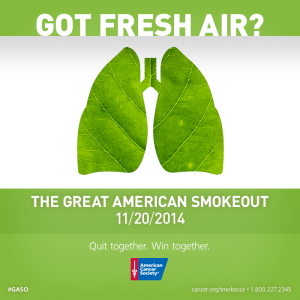Know a smoker?
The American Cancer Society marks the Great American Smokeout on the third Thursday of November — only a few days away.
The idea is to support smokers in using this day to quit… or at least to make a plan to quit smoking. Quitting — even for a day — is a step toward a healthier life. Moments after that last cigarette, heart rate and blood pressure both drop. Within hours? Carbon monoxide levels normalize.
[Tweet “Quitting smoking – even for a day – is a step toward a healthier life.”]
Don’t tell me… When it comes to the smokers in your life you’ve begged, pleaded and tried to coerce, right? You already know those things don’t work. Fear of failure often plays a role in smokers’ ambivalence about tackling one of the largest preventable causes of disease and premature death in this country.
[Tweet “Fear of failure often plays a role in smokers’ ambivalence”]
Once again, kindness and support may be the answer.
- You might want to research local options for free counseling, patches or support… but remember to ask permission before sharing it with your loved one.
- Should you loved one decide to quit offer to help “clear the air” (and any space) that might be triggering. For example, if they think it would be helpful, you could collect ashtrays, lighter and matches from around the house.
- Invite “your quitter” out to dinner or a movie — or to another enjoyable activity in a place that doesn’t allow smoking.
- Be available. Listen. Acknowledge the effort ~ your loved one is doing something very, very difficult.
- And ask. “I’m proud of you for making this effort ~ is there anything I can do to help you?”
[Tweet “I’m proud of you for making this effort ~ is there anything I can do to help?”]
##









